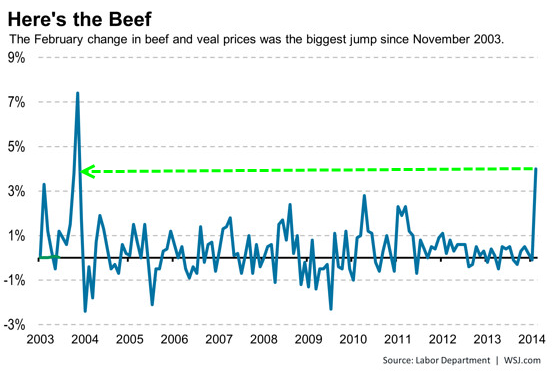Just a month ago we warned that food inflation was on its way. Today we got the first confirmation that problems are on their way. While headline data washes away the nuance of what eating, sleeping, energy-using human-beings are paying month-in and month-out, the fact, as WSJ reports, that beef prices surged by almost 5% in February – the biggest change since Nov 2003 – means pinching consumers and companies pocketbooks that are still grappling with a sluggish economic recovery. “Things are definitely more expensive,” exclaimed on mother of three, “I can’t believe how much milk is. Chicken is crazy right now, and beef – I paid $5 a pound for beef!” Just don’t tell the Fed!

Of course, it’s not just beef…
…prices also are higher for fruits, vegetables, sugar and beverages, according to government data. In futures markets, coffee prices have soared so far this year more than 70%, hogs are up 42% on disease concerns and cocoa has climbed 12% on rising demand, particularly from emerging markets.
…
Food prices have gained 2.8%, on average, for the past 10 years, outpacing the increase in prices for all goods, which rose 2.4%, according to the government.
…
Still, the price increases pose a challenge for food makers, restaurants and retailers, which must decide how much of the costs they can pass along and still retain customers at a time of intense competition and thin profit margins.During previous inflationary periods, food makers switched to less-expensive ingredients or reduced package sizes to maintain their profit margins. Retailers and restaurants usually raise prices as a last resort.
…
In California, the biggest U.S. producer of agricultural products, about 95% of the state is suffering from drought conditions, according to data from the U.S. Drought Monitor. This has led to water shortages that are hampering crop and livestock production.
U.S. fresh-vegetable prices that jumped 4.7% last year are forecast to rise as much as 3% this year, while fruit that gained 2% last year will rise up to 3.5% in 2014, according to the USDA.


